My original notion for my novel-in-progress Juicy Ghosts was that it would be a near-future Silicon Valley high-tech thriller. In my 2019 public talks in Miami and Pisa, Italy, I claimed that commercial telepathy isn’t all that far off. And Juicy Ghosts will, among other things, show a plausible path for this future tech. It’s useful to distinguish between what we might call peep, or lo-fi telepathy—and teep which is the h-fi telepathy of SF dreams.

Empty bulletin board near UC Berkeley Sather gate.
The most accessible type of “peep” is silent telephone calls. My device picks up my brain’s subvocal speech signals, converts them into audio files, sends the files across the web to your device, which converts the audio files into signals in the auditory nerve of your brain. You experience the signals as sound. You hear my voice in their head. While I’m at it, I can use my ear as a mic for you to eavesdrop through. And I can peep video to you as well. I tap the feed off my optic never and send it to your optic nerve. You’re experiencing my life as if I’m a remote.
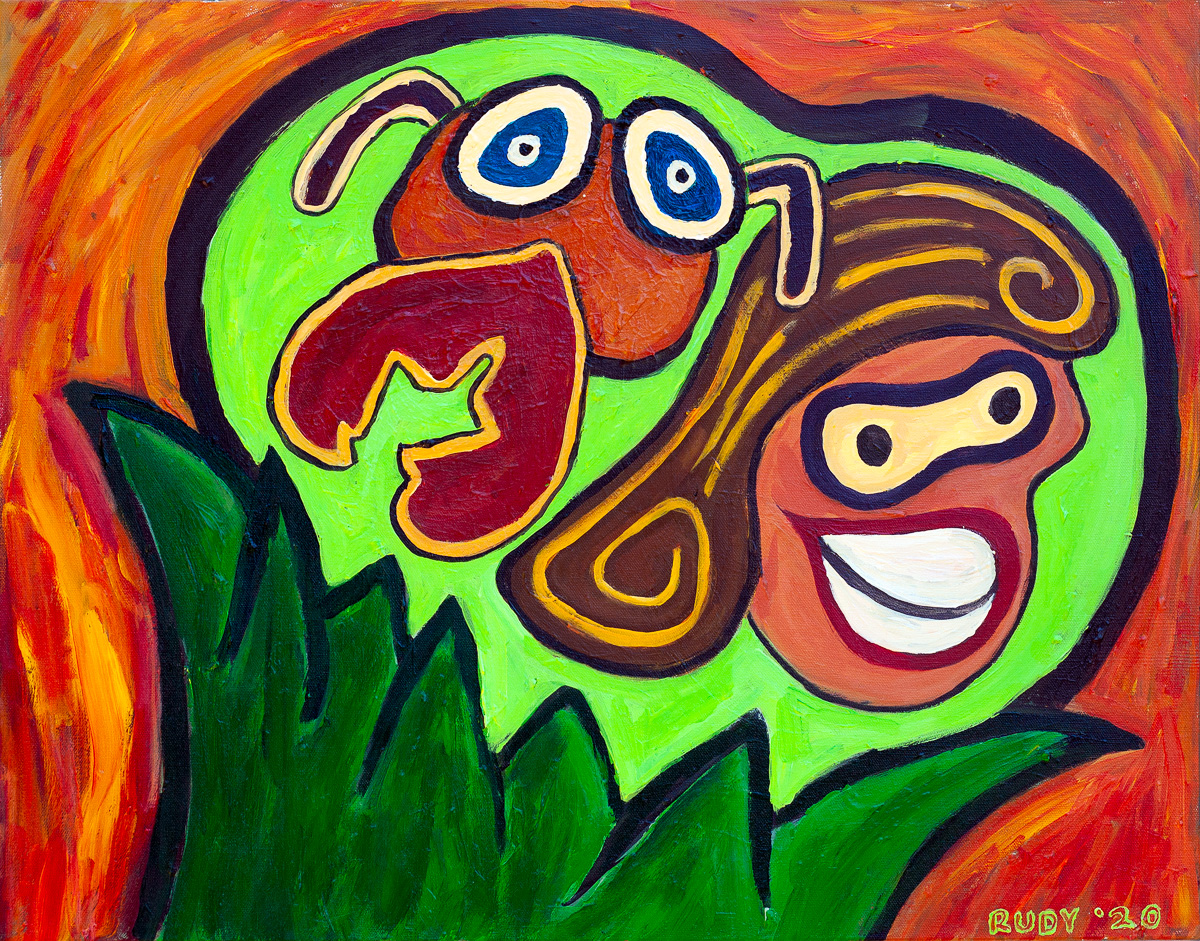
“Pinchy’s Big Date” acrylic on canvas, July, 2020, 28” x 22”. Click for a larger version of the painting.
There’s a whole history of the remote viewing trope. Living someone else’s experiences. Like in that very cool at the start (but then over-long) movie. Strange Days.
 Santa Cruz. From his seat, the driver sings Frank Sinatra songs.
Santa Cruz. From his seat, the driver sings Frank Sinatra songs.
In Juicy Ghosts, I’m talking about using a bio device called a psidot for this. To say this is a new idea would be cryptoamnesia , on my part, that is, a case of forgetfully thinking an old idea is fresh. I’ve written for years about a soft, intelligent plastic device that you wear on your neck for silent online access. I call it an uvvy. See, for instance, my 2004 blog post “Cyborgs, Future of Humanity.” And I write about uvvies in novels like Freeware and Jim and the Flims.
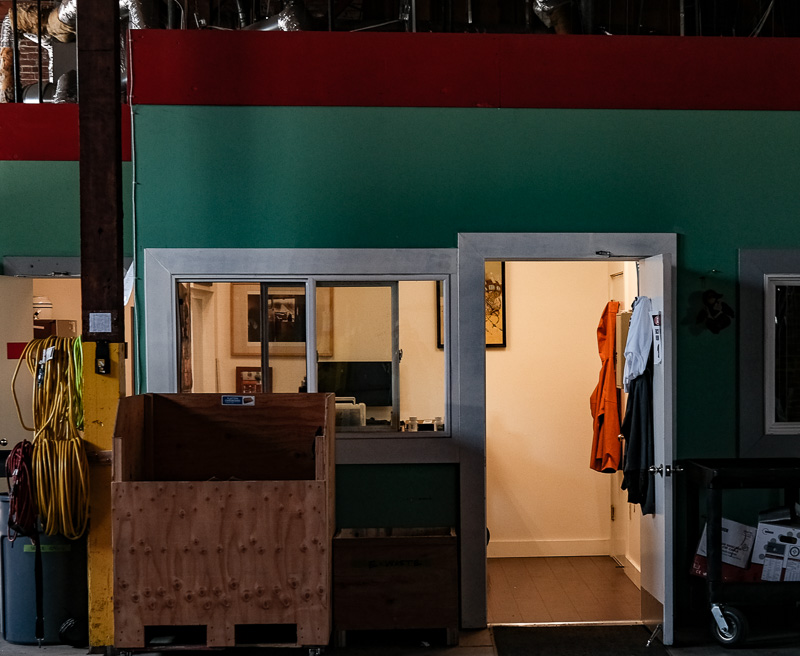
Room in a room at Monkeybrains Oakland warehouse.
By the way, I found that 2004 blog post I just mentioned by using my “Search Rudy’s Lifebox” web page to searcah for places where I’ve mentioned “uvvy.” Kind of cool to have this prototype online lifebox actually help me in planning a novel like Juicy Ghosts, which will include lifeboxes!

Anyway, the old uvvy is made of computational smart plastic, rather than being a living organism like the new psidot. The Juicy Ghosts novel will have both uvvies and psidots. The psidots will be edging closer to full, deep, telepathy of teep. The uvvies are like cheap old-model smart-phones and the psidots are the way-cool new ones. Naturally a psidot has a little emulation of an uvvy inside it.

Before going on to full teep, let’s talk about how to achieve peep, or silent phone calls and remote presence—these being the somewhat conceivable near-future uvvy tech. I have a ground rule that none of my future teep devices should require sending wires or tendrils through your skull and into your brain. And we’ll have no brain-implanted sensors. Otherwise, well, otherwise it’s not fun to think about.

This said, I do in fact have a brain-invading teep-device protoype called “stumble” in my Big Echo ezine tale, “The Mean Carrot,” which is a draft of Chapter One of Juicy Ghosts. Stumble is a shelf-mushroom-type fungus that sends tendrils or hyphae deep into the hapless users’ brains. But we’ll move on to sea slug psidots in Chapter Two!

Anyway, back to my original, earlier teep or peep devices: uvvies. These are soft lumps of intelligent computational piezoplastic. My uvvy on the back of my neck reads the faint ambient signals of my brainwaves, and it uses vortex signals to feed others’ brainwaves into my head.
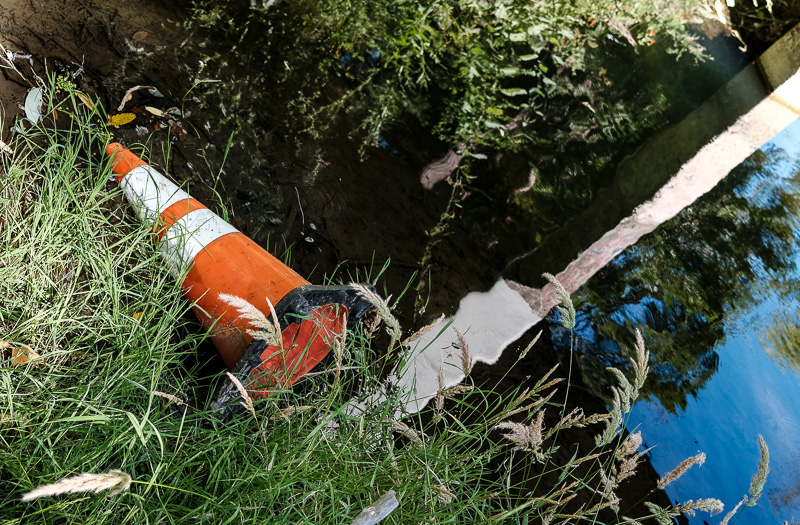
Not only can an uvvy do silent phone calls and remote viewing, there are uvvy apps for tingles and smells and tastes, too. And of course porn, spam, and ads—and blockers, filters, and firewalls. But that low, grasping stuff isn’t my bag. My eye is on the true teep. The hard part that uvvies can’t do.
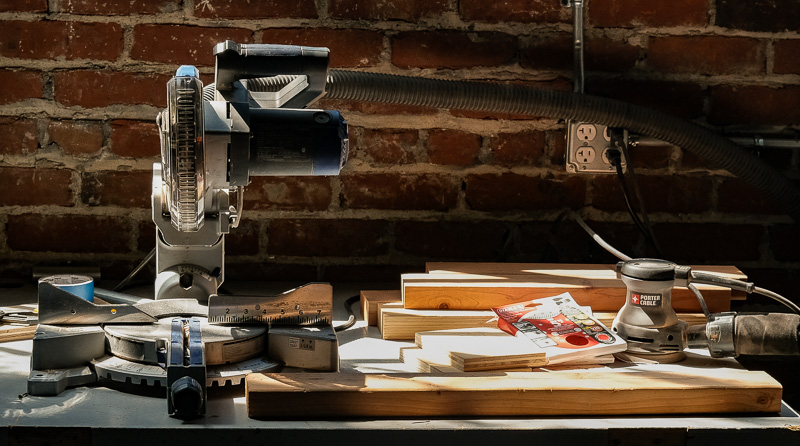
True hi-res teep would be where you’re sharing your inner visions, and your emotions, and your body sensations, and your rich thoughts. As I like to say, true teep would mean. for once in your life, being understood.
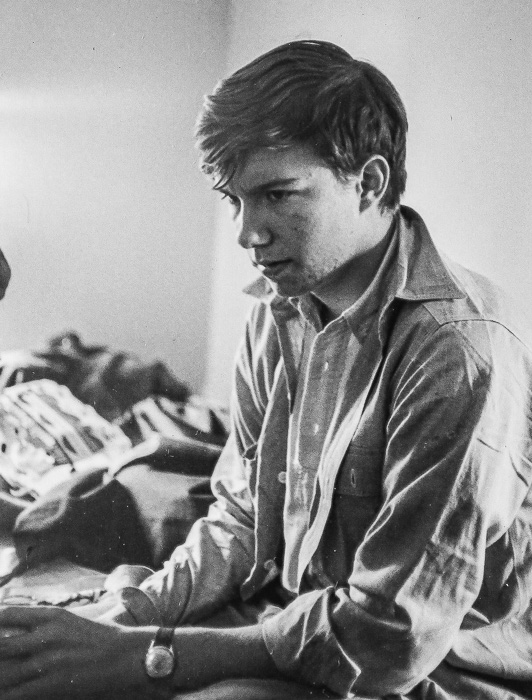
Rudy at 17, by Rob Lewine, at Swarthmore College, 1963.
Part of the full teep thing, or even the more light-weight peep, is that it helps to have a lot of context on the person you’re trying to communicate with. That is, a possible problem with full brain-link teep is that you might have trouble deciphering the intricate structures of someone else’s thoughts. Like you need to know something about a country’s culture to understand the language.
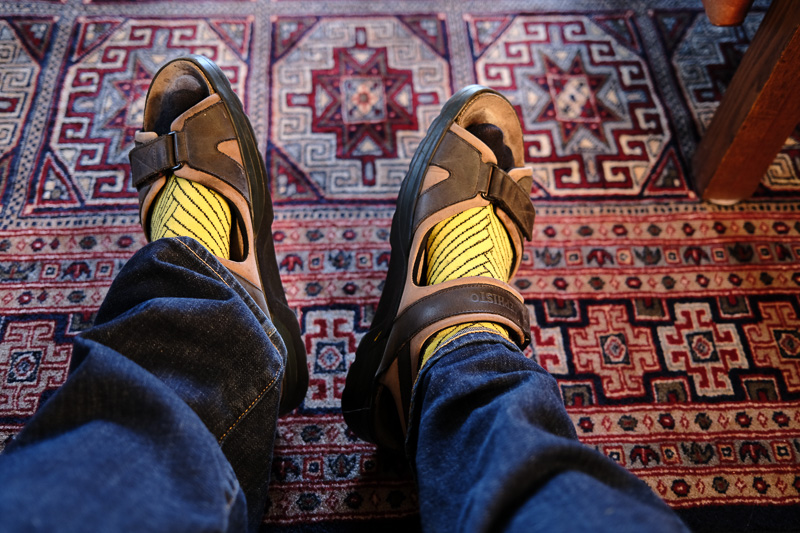
I’m always talking about these things called lifeboxes, a lifebox being an online model or database of you—like maybe everything you wrote, or interviews with you, or recordings. Sharing lifeboxes could help make sense of another person’s internal brain patterns. So when receiving the audio, video, and other signals from someone, it would help if the bits were annotated with hyperlinks into the other user’s lifebox. Have the notes be realtime and interactive.
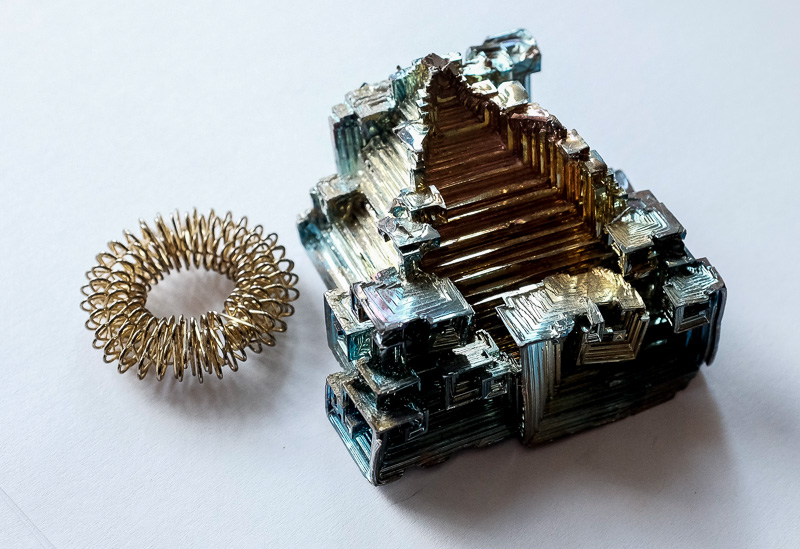
Bismuth crystal from Isabel.
There’s a variety of ways to segue from peep towards teep. Another angle is to send multi-track audio. A choir of the sender’s internal voices. The receiver hears a fugue of several tracks talking at once. It’s an effect I recall from, for instance, the supernal Firesign Theater album, We’re All Bozos on This Bus. And, again you’ve got interactive lifebox context whispering tips on how to understand the fugue.

Another approach to teep is say, to hell with it, we need some woo-woo quantum action. That’s what I did in my telepathy novel, The Big Aha. But maybe multiple tracks and multiple sensory modes can be enough. And the deep core thing, the “I am”—well, as I’ve always aid, that’s bascially the same for everyone, modulo emotional coloring

Oh, one more angle. I can chip away at sharing emotions via teep by using something like P. K. Dick’s notion of a “Penfield mood organ,” A device that plays your feelings. The “organ stops” could be emotion-generating hormones or, more indirectly, stimuli to regions like the adrenal gland, the thymus, and whatever else.
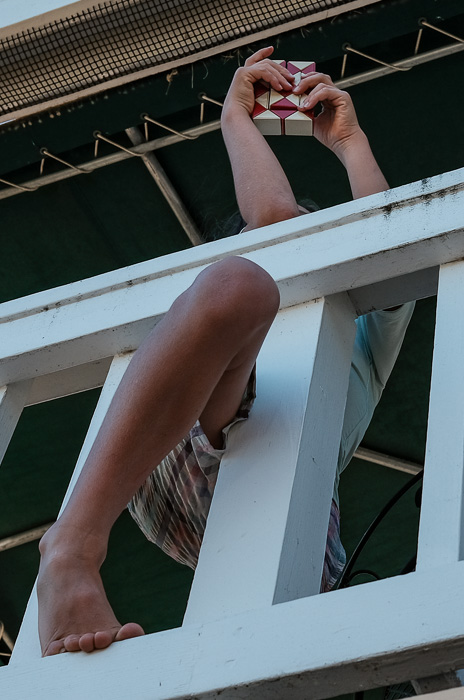
But I’ll open to teeping via quantum states. Many overlapping classical states in one. A vibe. Biotech ought to be good at that. I talked about this in my story “Juicy Ghost,” which is eventually going to be a chapter of Juicy Ghosts.
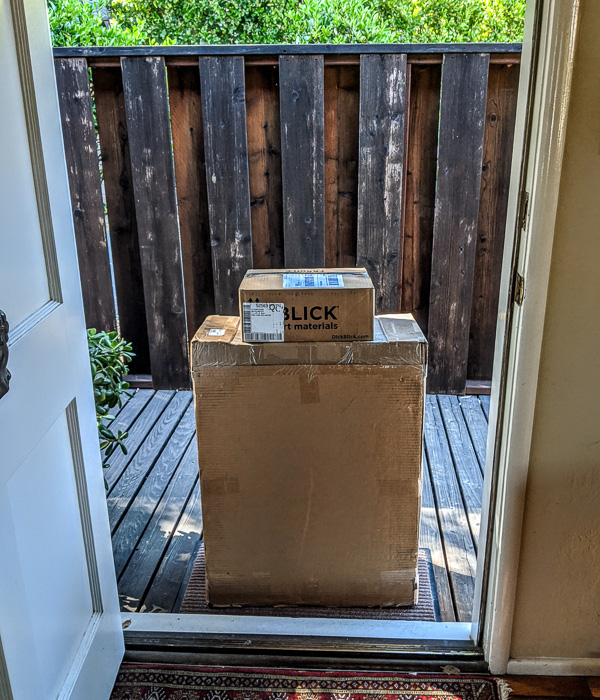
Meanwhile, I’m seriously trying to imagine telepathy, and to get, yet again, some kind of handle on what’s going on in my mind. Focusing on my flow of consciousness, thinking about how it would be to share that via true, deep telepathy. What’s in my mind? Well, this morning I typed this:
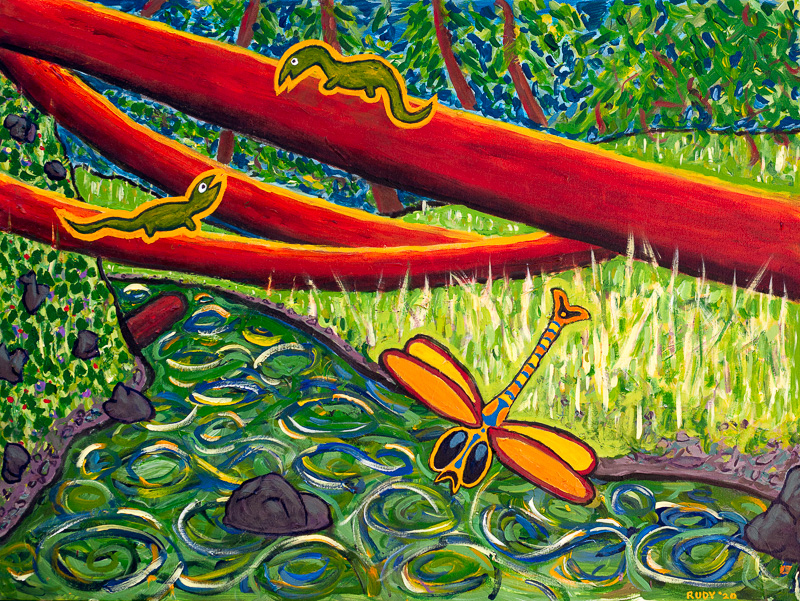
“Two Lizards” acrylic on canvas, July, 2020, 49” x 39”. Click for a larger version of the painting.
I hear Sylvia doing dishes upstairs, and her footsteps. Machines in the distance outside. Uneasy about having cleared brush off our hillside last week. I liked the brush. Tightness in my chest? The raspberry red of the quilt Sylvia made. Faint ringing in my ears. Memories of cicadas in Lynchburg and Louisville. The stacking of the dishes makes a two-step sound like walking. I see the shape of our house in three dimensions, the room with Sylvia is illuminated. The frames of my glasses constrict my vision. Take them off. Physical sense of myself typing, and the flesh of my body, and my crossed shinbones, and the sea-swell of my breaths. Some trivial device beeps nearby. I visualize my mind as a dark velvety zone inside my skull. Make a painting? With an R. Crumb oaf profile outline. What are the icons inside? A dog barking, a motor scooter, more footsteps. My skull is small. My tingling brain, and in the heart of it is my awareness, always there. Does yours feel the same? Itch, scratch, hair. Phosphenes in my visual field. Get into the shower. Glorious symphony of tunable water sounds. Daily the same.









August 11th, 2020 at 8:02 pm
A phone that picks up subvocalization would pick up babble. Lots of uhs and ums and wacky grammar. Compare a rough first draft of a line of dialog with the one you publish; that’s the difference between subvocalized speech and vocalized.
Actually I can see enormous comic potential in this. Anyone on the subvocalization phone would sound like an blithering idiot. Ditto peeping. So first you hear his inner blithering. Then you hear what he says. The latter much clearer, sensible, and calculated. The former too sincere.
A peeper would overhear plenty of private codes; expressions meaningful only in the context of that mind, and so a mystery to the peeper. Deep teep might detect the connections; but in so doing, the apparent identity of the one teeped dissolves into a web of parallel thoughts. It’s a Heisenbergian complementarity: teep the person but not understand most of the thoughts; or know the thoughts precisely but lose sight of the person. Forest or trees.
My daughter Hannah recently videoconferenced for her job. Afterwards she came to me to fulminate about guys with six-figure incomes who want a chip put in their brains. She questioned the sanity of surgery every time you need a hardware update. And of course there are cybersecurity issues.
I bet the brain-chip guy also wants to be uploaded. I’m not sure that would be better than dying, or even different. He commits the utopian fallacy: that new and untested will suck less that what we’ve got. Actually, suckitude is conserved; the posthuman condition will suck in ways beyond our comprehension. Life is nothing but trouble, yet people are for it.
August 11th, 2020 at 8:23 pm
I prefer my communications systems to be unimmersive. I’m me, sitting here, you’re you, over there. Put screens and keyboards and cameras between us, that’ll do. Okay, maybe my glasses can beam text and images onto my retina if you want to be cute about it, but I’ll wear those glasses as rarely as possible. Getting too involved sounds unsanitary somehow.
If you use my eyes as a remote, then your brain and mine will interpret the optic-nerve signals differently, and we will see different things. If for unity’s sake you tap my perceptions higher up, then you will see the same illusions I do.
With true teep you might indeed be truly understood; but understood, in a disturbing Zen sense, as an illusion. The teep finds in your mind everything but you.
In a related issue: I prefer pure instrumental music to songs with words. The first manipulates my emotions but leaves my thoughts alone.
August 11th, 2020 at 8:59 pm
A depiction of teeping:
First we read a wall of blithering word salad.
Right after that we see a shorter wall of text, edited from the previous wall, with some thoughts emerging.
Then a shorter text, again edited from the previous. with definite thoughts but contradictory and with mangled grammar.
Then contradictions deleted but still wacky grammar.
Then grammatical, sort of.
Then better.
Then what he actually says. It will be found within the original blither, but countermessages will also be there.
All these stages pass in a fraction of a second.
I think you could spend an entire chapter, one that reveals character and advances the plot, depicting a teep exchanging three sentences with someone. Make clear that this alienating way is how a teep always experiences conversations. They see too much.
The beauty part is that you, the author, get to flaunt your rough draft and your stumbling edits. Your crappy first draft will be an authentic depiction of the crappiness of first thought. The hard part will be making it crappy enough. Ironically, you’ll have to repeatedly rewrite it to make it sound blithering enough. Authenticity and artifice are yin and yang.
August 11th, 2020 at 9:15 pm
Great raps, paradoctor. I’ll mule them over. When our son was little, he always said “mull them over” that way. (That’s a layer.) I don’t necessarily see the layers as successive drafts. I think of them more as parallel paths. Like the descant floating above the bass and the alto. And your muttered rebelliou asides there with your polite remarks, and your background thoughts about pi / alef-three in there two, or is it too, or to, or tu. All is yum.
August 11th, 2020 at 10:01 pm
Parallel thought paths, to be sure. Inner conflict revealed, absolutely. But how to depict nonlinearity on the linear page?
Joyce tried fully nonlinear text in “Finnegan’s Wake”. It has a cult following but no more. (Like Russell’s “Principia”, doomed to obscurity. The moral: keep it simple, stupid!)
I propose successive drafts as an approximation legible by the reader. It’s an artifice to fake the authentic. Art is a lie that tells a deeper truth.
Mule it over. The gostack distims the doshes. Beep!